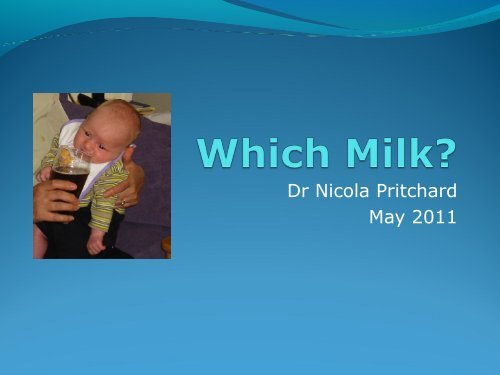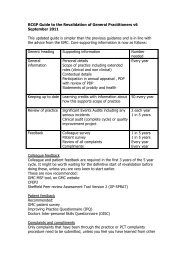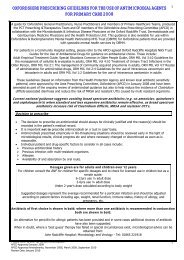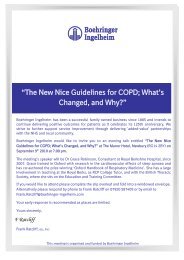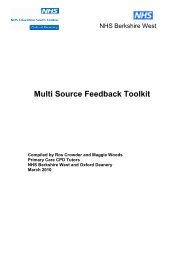Dr Nicola Pritchard.pdf
Dr Nicola Pritchard.pdf
Dr Nicola Pritchard.pdf
Create successful ePaper yourself
Turn your PDF publications into a flip-book with our unique Google optimized e-Paper software.
<strong>Dr</strong> <strong>Nicola</strong> <strong>Pritchard</strong><br />
May 2011
Why Breast feed?<br />
Immediate Benefits<br />
Nutritionally complete<br />
Hormones<br />
Growth factors<br />
Nucleotides<br />
Enzymes<br />
LC PUFA<br />
Live cells
Breast feeding -Longterm<br />
Long term Benefits<br />
Small effect BP (2mmHg)<br />
22% reduction in adult obesity<br />
Reduced cholesterol<br />
19-27% reduction IDDM<br />
39% reduction NIDDM<br />
36% reduction SIDS<br />
4.9 points IQ
Exclusive Breast Feeding UK<br />
Infant Feeding Survey 2005<br />
78% Initiation rates<br />
35% exclusively breastfed at one week<br />
21 % at six weeks<br />
7% at four months<br />
3% at five months<br />
Reduction<br />
Second baby<br />
Socioeconomic<br />
Education<br />
Age of mother<br />
ONS 2005 (2010 results due 2013)
UNICEF Baby Friendly<br />
Breast feeding Policy<br />
Education and Advice<br />
Early first feed<br />
Skin-to-skin<br />
Privacy<br />
Adequate rest, food and drink<br />
Support for expressing<br />
Formula milk should not be given to breastfed<br />
babies unless medically indicated.<br />
Avoid dummies
RBH<br />
Breast Feeding Clinic<br />
Contact<br />
Rose Tilbury, Lead Midwife for Breast Feeding<br />
Breastfeeding clinic hours<br />
Weekday 10.00am - 13.00pm<br />
Appointments 322 8964.<br />
Breastfeeding classes<br />
Maternity unit Tuesday 2-4pm<br />
To book Tel: 322 8964 between 9-5pm.
Breastfeeding<br />
How to know if it is successful?<br />
Indicators of good attachment and positioning<br />
mouth wide open<br />
less areola visible underneath the chin than above nipple<br />
chin touching breast, lower lip rolled down, and nose free<br />
no pain<br />
Indicators of successful feeding in babies<br />
audible and visible swallowing<br />
sustained rhythmic suck<br />
relaxed arms and hands<br />
moist mouth<br />
regular soaked/heavy nappies<br />
Indicators of successful breastfeeding in women<br />
breast softening<br />
no compression of the nipple at the end of the feed<br />
woman feels relaxed and sleepy.
When should a new mother<br />
be advised against breastfeeding?<br />
Diagnosis of galactosaemia<br />
Pregestamil or soya formula<br />
+/- HIV<br />
+/- Hepatitis B<br />
IMPORTANT WHO Advice<br />
<br />
All infants must be managed individually; insufficient<br />
growth or other adverse outcomes not to be ignored
Mastitis<br />
Women should be offered assistance & advice<br />
Positioning and attachment<br />
Continue breastfeeding and/or hand<br />
expression<br />
Analgesia compatible with breastfeeding<br />
Increase fluid intake.
Advantages of<br />
Pre-term Maternal Milk<br />
Higher macrophages and Ig A<br />
More energy, lipid, LC PUFA, Protein, iron and<br />
vitamins<br />
Skin to skin – Maternal Ig A transfer<br />
Need to express at least 4 x day<br />
Aim for 100mins a day
Milk Banks<br />
Collection of donor “drip milk” from term mothers<br />
Positive<br />
79% reduction in NEC<br />
But<br />
NOT preterm milk<br />
Fore rather than hind milk<br />
Lower protein, sodium zinc and copper<br />
Loss of “live” immune protection<br />
Viral infection risk
What should I do?<br />
Breast fed pre-term infant not gaining weight<br />
Options<br />
Increase volume<br />
Check for other reasons<br />
Fortify?<br />
Evidence for fortifying milk<br />
Short term improved weight gain<br />
No evidence for increase in NEC<br />
? Osmolality
General Advice<br />
Breast Milk Fortifiers<br />
Max volumes of EBM tolerated first<br />
Only use after first 2 weeks<br />
Fortify milk as close as possible to the feed<br />
time.<br />
Assess closely for feed intolerance<br />
Change only one thing at a time<br />
Do not use if strong FHx of atopy<br />
Don’t add to preterm or term formula
Formula milks<br />
Whey based<br />
More similar to breast milk<br />
Caesin based<br />
Claimed to be better for hungry babies<br />
Strict guidelines<br />
More calcium and phosphate than cows milk<br />
More iron<br />
LC PUFA<br />
Component of cell membrane of CNS and retina
Follow on milks<br />
UK recommendations for term infants<br />
Not prior to 6 months<br />
Why<br />
More iron (cover low iron weaning)<br />
More vitamin D<br />
Less saturated fatty acids<br />
Not required if thriving
What the Mum’s want to know
Nucleotides<br />
Evidence available to support<br />
Growth enhancement of babies born light for<br />
gestational age<br />
Decreased episodes of diarrhoea<br />
Greater antibody responses to primary<br />
immunisations<br />
Theoretical<br />
Changes in lipid metabolism - ? Effect<br />
Br J Nutr. 2007 Immune response to nucleotide-supplemented infant formulae: systematic review &<br />
meta-analysis.
Pre and Probiotics<br />
Breast fed infants colonised within 12-24 hrs<br />
Bifidobacteria and Lactobacilli<br />
Fermentation of carbohydrates<br />
Causes fall in colonic pH<br />
Favours growth of non-pathogenic species<br />
Improved mucosal barrier
Pre and Probiotics<br />
Prebiotics<br />
Currently Added<br />
Non-digestable<br />
oligosaccharides<br />
Mimics breast milk<br />
Promotes bowel flora<br />
similar to breast fed<br />
infants<br />
Studies underway for<br />
preterm formula<br />
<br />
The Preterm Prebiotic Study Imperial College<br />
Neena Modi, ?Improved feed intolerance<br />
Probiotic<br />
Not recommended<br />
Live microbial food<br />
supplement<br />
Colonise GI tract<br />
Synthesise<br />
Short chain fatty acids<br />
Amino acids<br />
?Infection risk<br />
?How much<br />
?Regulation<br />
?Which organism
Prebiotics in Formula<br />
Stool flora similar to breast fed infants<br />
?Reduction in diarrhoeal episodes<br />
Prebiotics for prevention of allergic disease or<br />
food reactions<br />
Insufficient evidence COCHRANE 2008
Probiotics & Preterm Infants<br />
Reduces the occurrence of NEC (stage 2) and death
Long Chain<br />
Poly Unsaturated Fatty Acids<br />
Docosahexanoeic Acid (DHA Omega 3)<br />
Arachidonic Acid (AA Omega 6)<br />
Variable amounts in breast milk<br />
Constituent of cell membranes and retina<br />
Small studies support improved visual and<br />
cognitive development<br />
Recent RCT Jan 2010 J Ped Gast & Nut<br />
No difference in Baileys at 18 months
Preterm Formula<br />
Standard preterm formula<br />
Usually until 2-2.5kg<br />
More calories and protein than breast milk<br />
Amino acids similar to breast milk<br />
LC PUFA<br />
Vit D
NEC Risk<br />
Formula vs EBM<br />
Exclusively formula fed<br />
6 x rate of NEC<br />
Mixed BF and formula<br />
3 x rate of NEC<br />
Breast Milk<br />
Matures GI tract<br />
Alters bowel flora<br />
Source of growth factors<br />
Matures and provides immune factors
How to feed<br />
Minimal enteral feeds<br />
Orogastric vs Nasogastric<br />
?Transpyloric<br />
Continuous vs Bolus (Cochrane 2008 Insuff evidence)<br />
Demand vs Timed (Cochrane 2008 Insuff evidence)<br />
Non-nutritive sucking
ADEPT Abnormal Doppler Enteral Prescription Trial<br />
Entry Criteria<br />
Antenatal ultrasound<br />
<br />
Absent or reversed EDF or Cerebral redistribution<br />
Pre-term:<br />
Post Discharge Formula<br />
Most pre term infants discharged small for<br />
gestation<br />
Rapid growth – high calorific requirement<br />
Can consume 300mls/kg/day normal formula<br />
<br />
Not an issue if tolerated<br />
Increased risk of long-term growth failure<br />
Better catch up<br />
<br />
Theoretically better brain growth – but not proven
Post discharge Formula<br />
ESPHGAN position statement May 2006<br />
If appropriate wt for gestn: Breast or term<br />
formula<br />
Post discharge formula if not<br />
How long?<br />
At least until CGA 40 weeks<br />
Possibly until CGA 52 weeks<br />
EG Nutriprem 2<br />
RBH Guideline being developed<br />
Halway between preterm and term formula
Is it Milk Allergy Doctor?<br />
Diarrhoea<br />
Pain<br />
Flatus and abdominal distention<br />
Perianal excoriation<br />
Other – older children<br />
<br />
Non specific symptoms such as headache or fatigue<br />
Investigations – not necessary<br />
<br />
Positive stool reducing substances supportive
Lactose Intolerance<br />
Congenital form rare - from birth<br />
Secondary<br />
Onset in infants/children<br />
Secondary to GI infection<br />
<br />
Self limiting in majority in 6=8 weeks<br />
Non resolving consider coeliac disease<br />
Primary Inherited Lactase deficiency<br />
Usually adolescent onset in UK population<br />
Non specific symptoms: thought secondary to effects of<br />
bacterial short chain fatty acid uptake<br />
Can usually tolerate 240mls milk/day<br />
Lactase capsules can be helpful
Infant Management<br />
Infant Treatment<br />
Avoid lactase and maintain nutrition<br />
At least 6 weeks if post gastroenteritis<br />
Lactose free formula<br />
Commercial lactose free or prescribable formula<br />
SMA LF<br />
Cow and Gate Comfort<br />
Enfamil LF<br />
Pregestamil<br />
Nutramigen<br />
Soya milks (consider if >6 months)<br />
Lactose free cows milk if > 12 months
Soya formulae<br />
BDA 2004<br />
<br />
<br />
<br />
<br />
ONLY INDICATIONS<br />
Galactosaemia<br />
Second line for other<br />
NOT FOR<br />
CMPI<br />
Anaphylaxis<br />
Not < 6 months<br />
No evidence<br />
Reduction in: colic/crying/allergy<br />
CONCERNS<br />
Poorer nitrogen source<br />
Phytate may affect absorption of minerals/iodine<br />
<br />
<br />
10x aluminium content<br />
Phyto-oestrogens<br />
Male infertility and menstrual disturbance
Is it Milk Allergy Doctor?<br />
Reaction within hours of ingestion<br />
Blotchy facial rash<br />
Vomiting<br />
Atopic FHx<br />
Investigations?<br />
+/- Positive RAST/skin<br />
+/- Elevated total Ig E<br />
NB Can occur with NEGATIVE tests
Type 1 Hypersensitivity<br />
Cows Milk Allergy<br />
Differentiate from intolerance<br />
Eliminate all cows milk, mammalian milk and<br />
soya<br />
Advise re life threatening features<br />
Refer to paediatrician<br />
Treatment: Avoid ALL animal and soya milk<br />
products until 18 months
Anaphylaxis<br />
Type 1 Hypersensitivity<br />
Milk options<br />
Fully hydrolysed Nutramigen 1 and 2<br />
Elemental<br />
Over 1 year<br />
Aptamil Pepti<br />
Pepti Junior<br />
Neocate/Neocate Active<br />
Nutramigen AA<br />
<br />
Calcium enriched vegetable milks
Is it Milk Allergy Doctor?<br />
Age 1 week – 3 months<br />
Bloody diarrhoea<br />
Malabsorption<br />
GOR Sx
Cows Milk Protein<br />
Intolerance<br />
Non Ig E Mediated<br />
Delayed and cumulative effect<br />
Gastro-oesophageal reflux/Vomiting<br />
Diarrhoea<br />
Constipation<br />
Colic<br />
Blood in stool (commoner infants)<br />
Iron deficiency anaemia<br />
Dermatitis/Eczema<br />
Rhinitis<br />
NB No evidence milk free diet improves wheeze
Management<br />
No specific supportive test<br />
Can occur in breast fed infants<br />
Diagnosis due to resolution of symptoms on<br />
exclusion diet<br />
Maternal dairy free diet<br />
Dairy and soya free diet<br />
Refer if under 1 year
Cows Milk Protein Intolerance<br />
Milk options<br />
Partially hydrolysed<br />
Pregestamil<br />
Nan HC<br />
Fully hydrolysed Nutramigen 1 and 2<br />
Aptamil Pepti<br />
Pepti Junior<br />
Elemental<br />
Neocate/Neocate Active<br />
Nutramigen AA<br />
NB Advise parents NOT same as lactose intolerance or<br />
anaphylaxis
On going Management<br />
Tolerance improves with age<br />
May tolerate some soya and/or dairy desserts<br />
or cheese towards age of 1 year<br />
Usually tolerate cows milk by 18 months - 2<br />
years<br />
Can rechallenge in community if > 1year and<br />
no history suggestive of type 1 reaction
Is it Milk Allergy Doctor?<br />
< 9 months<br />
Delayed reaction (hours not immediate) after milk<br />
ingestion<br />
Severe diarrhoea and dehydration<br />
Vomiting<br />
Collapse<br />
May appear like sepsis<br />
Also may occur with rice, cereals or meats
Food Protein Induced Enterocolitis<br />
Non Ig E mediated<br />
Older age of onset than Cow milk protein<br />
Enterocolitis<br />
Profuse D&V, dehydration and shock<br />
Elevated blood leucocytes<br />
Due to release of TNF alpha<br />
Referral to Tertiary Allergy Specialist for<br />
careful exclusion diet of milk, animal and<br />
cereal proteins
Is it Milk Allergy Doctor<br />
Older child<br />
GORD symptoms unresponsive to medical<br />
therapy<br />
+/- Atopy<br />
Normal or elevated blood Eosinophils
Eosinophilic Oesophagitis<br />
Biopsy diagnosis<br />
Increasingly common diagnosis (10:100,000)<br />
Treatment Options<br />
Refer to paediatric gastroenterology<br />
Exclusion diet - Neocate
Goats Milk Formula<br />
Goat infant formula not really available in UK<br />
Commonest mammalian milk in UK Goat milk<br />
Not nutritionally complete<br />
Low folic acid<br />
Higher saturated fats<br />
Often unpasteurised –risk of TB<br />
Not for
Other Mammalian milks<br />
Type 1 Reactions and CMPI<br />
High cross-reactivity to cows milk DO NOT USE<br />
Lactose Intolerance<br />
Lactose content very similar in all<br />
Cow 4.7%, Goat 4.7%, Buffalo 4.86%<br />
Yak 4.93%, Sheep 4.6%<br />
Apparently bear and kangaroo milk are low<br />
lactose
Rice Milk<br />
No lactose<br />
Low calcium<br />
Low cholesterol<br />
RESTRICTIONS<br />
“High” levels of inorganic arsenic<br />
FSA - Not for under 5 years (May 2009)<br />
Always recommend calcium enriched
Oat Milk<br />
Suitable for vegans<br />
No lactose<br />
No cholesterol<br />
Lower protein<br />
Low vitamins and calcium<br />
Commercial brands of milks<br />
Fortified with calcium equivalent to cows milk
Prescribable Formula<br />
Hydrolysed Formula<br />
Elemental Formula<br />
Hydrolysed milk<br />
protein<br />
Hypoallergenic<br />
Examples<br />
Pregestamil<br />
Nutramigen<br />
Nan HC<br />
Aptamil Pepti<br />
Synthetic amino<br />
acids<br />
For severe<br />
malabsorption or<br />
allergy<br />
Examples<br />
Neocate<br />
Nutramigen AA
Other Formulas<br />
Thickened formula<br />
Enfamil AR<br />
SMA Staydown<br />
Cow and Gate Comfort<br />
Anti-colic ?Evidence<br />
Low Lactose
High Energy options<br />
SMA High Energy (0.9kcal/ml)<br />
Infatrini (1kcal/ml)<br />
Similac (1kcal/ml)<br />
Duocal – carbohydrate and fat<br />
Maxijul- carbohydrate<br />
Concentrating formula?<br />
Powder first water second
Thank<br />
you


